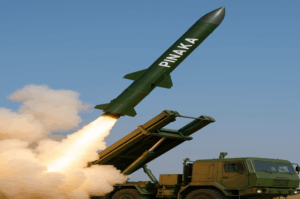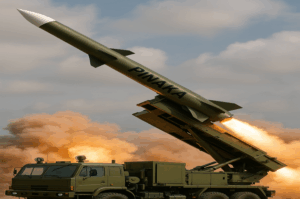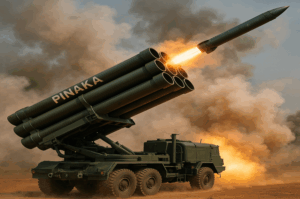What is Pinaka Missile?
The Pinaka missile system is a multi-barrel rocket launcher developed by India for quick and accurate firepower delivery. Named after Lord Shiva’s divine bow, Pinaka is designed for saturation bombardment with a high volume of fire over a large area, neutralizing enemy positions, airstrips, and bunkers efficiently. Developed by the Defence Research and Development Organisation (DRDO), it plays a crucial role in India’s artillery modernization program.
Table of Contents
Toggle| Feature | Details |
|---|---|
| Type | Multi-Barrel Rocket Launcher (MBRL) |
| Developed by | DRDO |
| Used by | Indian Army |
| Name origin | Derived from Lord Shiva’s bow |
Technical Specifications
The Pinaka missile system is engineered with advanced navigation, control, and fire control systems. It includes a multi-tube launcher mounted on a truck, allowing it to fire a salvo of 12 rockets in 44 seconds. It is capable of neutralizing targets up to 75 km away, depending on the version.
| Specification | Value |
|---|---|
| Range | 37 km (Mark-I), 75+ km (ER variants) |
| Caliber | 214 mm |
| Number of tubes | 12 |
| Launch Time | 44 seconds for full salvo |
| Reload Time | ~15 minutes |
| Guidance | Inertial/NavIC-based (in upgraded versions) |
Variants and Upgrades
The Pinaka system has undergone several improvements since its inception. From the baseline Pinaka Mk-I, the system has evolved into Mk-II and extended range (ER) variants, incorporating advanced navigation and precision targeting systems.
| Variant | Features |
|---|---|
| Pinaka Mk-I | Initial version with 37 km range |
| Pinaka Mk-II | Enhanced accuracy with guidance system |
| Pinaka ER | Extended range of up to 75+ km |
| Guided Pinaka | Uses GPS/NavIC guidance for precision strikes |

Operational Use
Pinaka has been actively deployed along the India-Pakistan and India-China borders. It has been used in live operations and war exercises such as Operation Vijay during the Kargil War. Its mobility and rapid deployment capability make it ideal for mountain and desert warfare.
| Deployment Area | Operational Notes |
|---|---|
| Western Borders | Regularly deployed in Rajasthan |
| Northern Borders | Used near LAC with China |
| Kargil Conflict | Played a key role in bombardments |
| Exercises | Used in ‘Topchi’, ‘Brahmastra’ drills |
Read More: Brahmos missile
Strategic Importance
Pinaka significantly boosts India’s tactical firepower, acting as a force multiplier in limited war scenarios. Its rapid deployment, indigenous development, and scalability make it a cornerstone of India’s “Make in India” defence initiative and a credible deterrent against hostile neighbors.
| Strategic Aspect | Importance |
|---|---|
| Indigenous Capability | Reduces dependency on foreign arms |
| Area Denial Weapon | Disrupts enemy formations |
| Export Potential | Attracts interest from friendly nations |
| Scalable System | Easily integrated into mobile units |
International Perspective
Countries like Armenia have shown keen interest in the Pinaka system, leading to export discussions. Its cost-efficiency, adaptability, and successful battlefield record have drawn global attention, especially among nations seeking alternatives to Western systems.
| Country | Interest/Engagement |
|---|---|
| Armenia | Confirmed buyer |
| France | Technical cooperation explored |
| Southeast Asia | Informal interest noted |
| African Nations | Evaluating for national defence upgrades |
Associated Technologies
Pinaka is a platform that integrates multiple Indian technologies. It features automated fire control, GPS-based guidance systems, and electronic countermeasures. The system is supported by Tata Power SED and L&T for launcher production.
| Technology | Integration in Pinaka |
|---|---|
| NavIC Navigation | Guidance in upgraded versions |
| Fire Control System | Automated targeting |
| ECM Modules | Jam resistance |
| Automated Reloading | Speeds up battlefield reusability |
Current Affairs & News
In 2023–24, India finalized the export of the Pinaka system to Armenia, marking a major milestone in indigenous weapon sales. Several upgrades are underway to develop Pinaka Mk-II with 120+ km range and guided precision capabilities.
Manufacturer of Pinaka Missile
The Pinaka system was developed by DRDO, and its production is carried out by Tata Advanced Systems, Bharat Forge, and Larsen & Toubro, among others.
| Manufacturer | Role in Production |
|---|---|
| DRDO | R&D and design |
| Tata Advanced Systems | Launcher and support systems |
| Bharat Forge | Rocket manufacturing |
| L&T | System integration and logistics |

Pinaka Missile Armenia
India signed a deal with Armenia in 2022–2023 to supply Pinaka systems under a multi-million dollar agreement, enhancing bilateral defence cooperation.
| Aspect | Details |
|---|---|
| Buyer | Armenia |
| Agreement Year | 2022–2023 |
| Package Includes | Pinaka systems, ammunition, support |
| Strategic Impact | Boosts India’s defence exports |
Pinaka Missile Developed By
The Pinaka missile was developed by India’s premier defence research organization, the DRDO (Defence Research and Development Organisation), in collaboration with private firms for mass production.
| Entity | Contribution |
|---|---|
| DRDO | Core research, testing, development |
| ARDE | Armament Research & Development |
| BDL | Ammunition production |
Pinaka Missile Export to Which Country
India has officially exported the Pinaka missile system to Armenia, and discussions are underway with Vietnam, Philippines, and African nations.
| Country | Export Status |
|---|---|
| Armenia | Confirmed |
| Vietnam | Under negotiation |
| Philippines | Expressed interest |
| African nations | Informal inquiries |
Pinaka Missile France
Although France has not purchased Pinaka, France has shown interest in collaborating with India in missile guidance and technology-sharing domains.
| France’s Role | Status |
|---|---|
| Buyer | No |
| Technology Partnership | Being explored |
| Joint R&D Possibility | Under strategic dialogue |
Pinaka Missile Launcher
The Pinaka launcher is a truck-mounted, high-mobility platform capable of launching 12 rockets in rapid succession. It is automated, reducing crew fatigue and response time.
| Launcher Type | Specifications |
|---|---|
| Platform | High-mobility truck chassis |
| Tube Count | 12 |
| Reload Mechanism | Automated |
| Manufacturer | Tata Advanced Systems, L&T |
Read More: mig 29
Pinaka Missile Made By
The missile and system are jointly made by DRDO and private Indian defence firms such as Bharat Forge, Tata Advanced Systems, and L&T.
| Component | Made By |
|---|---|
| Launcher | Tata, L&T |
| Rocket | Bharat Forge, Solar Industries |
| Electronics | BEL, ECIL |
Pinaka Missile Range
The range of Pinaka varies by variant. The original Mk-I version could reach 37 km, while the upgraded Mk-II and ER versions can reach up to 75+ km, with 120 km variants in development.
| Version | Range |
|---|---|
| Mk-I | 37 km |
| Mk-II | 60 km |
| ER Variant | 75+ km |
| Future Variant | 120 km (under testing) |

Pinaka Missile Speed
Pinaka rockets travel at supersonic speeds, reaching Mach 2 to 2.5 depending on payload and variant, allowing for swift neutralization of targets.
| Variant | Speed |
|---|---|
| Standard | Mach 2 |
| Guided Variant | Mach 2.5 |
Pinaka Missile System
The system comprises launchers, rockets, a loader-cum-replenishment vehicle, command post, and meteorological radar, creating a comprehensive mobile artillery solution.
| Subsystem | Function |
|---|---|
| Multi-Barrel Launcher | Rocket delivery |
| Loader-Cum-Replenishment | Reloads system quickly |
| Command Post Vehicle | Fire control and communications |
| Weather Radar | Supports trajectory calibration |
This structured content on the Pinaka Missile provides both an in-depth explanation and easy-to-reference data, catering to researchers, defence enthusiasts, and policy analysts alike.
Future Development and Modernization Plans
India is committed to modernizing the Pinaka missile system as part of its long-term strategic defense goals. DRDO is currently working on enhancing the system’s range to 120 km and beyond, as well as improving guidance, precision targeting, and mobility. The integration of NavIC satellite navigation and AI-based fire control systems are on the roadmap for future versions.
| Development Goal | Status |
|---|---|
| 120+ km Range Variant | Under advanced testing |
| Precision Strike Capability | Being integrated via GPS/NavIC |
| Artificial Intelligence (AI) | Planned for future fire systems |
| Lightweight Mobility Platform | Under design consideration |
Pinaka Missile vs Other Global Rocket Systems
Pinaka competes with several global multi-barrel rocket systems, such as the HIMARS (USA), BM-30 Smerch (Russia), and AR2 (China). While it may not surpass Western precision systems in all parameters, it offers exceptional cost-effectiveness, ease of production, and mobility in harsh terrains like the Himalayas and deserts.
| System | Country | Range | Key Feature |
|---|---|---|---|
| Pinaka | India | Up to 75+ km | Cost-effective & mobile |
| HIMARS | USA | ~70 km (GMLRS) | High-precision, expensive |
| BM-30 Smerch | Russia | Up to 90 km | Heavy saturation attack |
| AR2 MLRS | China | ~130 km | Extended range capability |
Pinaka in Indian Military Doctrine
Pinaka aligns with India’s Cold Start Doctrine, which emphasizes rapid, localized, and intense strikes to gain tactical advantage without full-scale war escalation. It provides quick firepower without needing long deployment times, especially along India’s sensitive borders.
| Doctrine Aspect | Role of Pinaka |
|---|---|
| Cold Start | Fast saturation bombardment |
| Tactical Superiority | Destroys enemy positions instantly |
| Rapid Deployment | Mobile launchers for swift movement |
| Low-Casualty Strategy | Minimizes infantry risk |
Challenges and Limitations
Despite its success, the Pinaka system faces some challenges, including limited precision in unguided variants, logistical complexity during high-volume operations, and the need for increased automation to match Western standards. Addressing these will be vital to maintain competitiveness.
| Challenge | Notes |
|---|---|
| Precision in Mk-I | No terminal guidance |
| Heavy Reload Time | Takes ~15 minutes |
| System Weight | Restricts deployment on soft terrain |
| Export Regulations | Subject to MTCR and defense policies |
Pinaka in Global Defence Markets
India’s push for defence exports under the ‘Atmanirbhar Bharat’ (Self-reliant India) initiative has positioned Pinaka as a viable product in the global defense market. With successful exports to Armenia and negotiations ongoing with Vietnam and African nations, Pinaka is India’s flagship artillery export.
| Region/Country | Engagement Type |
|---|---|
| Armenia | Confirmed export |
| Vietnam | In advanced talks |
| Philippines | Initial inquiry stage |
| African Defence Forums | High interest due to affordability |
Read More: Barak 8
Conclusion
The Pinaka missile system is a shining example of India’s indigenous defense innovation and strategic foresight. Developed by the Defence Research and Development Organisation (DRDO), Pinaka has evolved from a basic multi-barrel rocket launcher into a sophisticated guided artillery system with increasing range, precision, and mobility. Its operational deployment along critical borders, coupled with its successful export to countries like Armenia, showcases its battlefield reliability and global relevance.
With continued upgrades, such as satellite-guided navigation, longer-range variants, and AI-based fire control systems in the pipeline, Pinaka is well-positioned to meet the challenges of modern warfare. Its ability to deliver swift, large-volume firepower makes it a cornerstone in India’s Cold Start Doctrine and a vital asset in the nation’s deterrence capabilities.
Moreover, the system’s cost-effectiveness, ease of deployment, and modularity make it an attractive option for other countries, further strengthening India’s presence in the global defense market. As India pushes for self-reliance in defense production under the Atmanirbhar Bharat initiative, the Pinaka system stands as a symbol of technological progress, strategic maturity, and growing defense diplomacy.
In essence, Pinaka is not just a weapon system—it is a force multiplier, a global contender, and a marker of India’s ascent as a defense technology powerhouse.
Key Facts at a Glance
| Category | Details |
|---|---|
| Type | Multiple Launch Rocket System (MLRS) |
| Place of Origin | India |
| Designer | Armament Research and Development Establishment (DRDO) |
| Design Period | 1986–present |
| Manufacturer(s) | – Rockets & Ammunition: Yantra India, Solar Industries – Launchers & Vehicles: Tata Advanced Systems, Larsen & Toubro |
| Unit Cost | ₹430 crore (₹506 crore or US$60 million in 2023) per regiment |
| Production Period | 1994–present |
| Used In War(s) | Kargil War |
Technical Specifications
| Feature | Specification |
|---|---|
| Length | 2.91–5.17 m (9 ft 7 in – 17 ft 0 in) |
| Diameter | 122–214 mm (4.8–8.4 in) |
| Caliber | 122 mm (ERR 122), 214 mm (Pinaka Mk-I, Mk-I Enhanced, Mk-II, Mk-II ER) |
| Number of Barrels | 12 |
| Elevation | 55° |
| Traverse | 90° |
| Rate of Fire | 12 rockets per launcher or 72 per battery in under 44 seconds |
| Effective Range | 37.5 km to 75 km |
| Max Firing Range | 90 km |
| Warhead Types | HE fragmentation, cluster, incendiary, anti-personnel, anti-tank, mine-laying |
| Warhead Weight | 100 kg to 250 kg |
| Detonation Mechanism | Contact, proximity, electronic time fuze |
Propulsion & Mobility
| Component | Specification |
|---|---|
| Engine | T-930 multi-fuel turbocharged V8 with intercooler |
| Propellant | High-energy composite solid fuel |
| Payload Capacity | 22 tonnes |
| Suspension | Leaf spring and air suspension with telescopic shock absorbers |
| Operational Range | ~800 km |
| Launcher Speed | 80 km/h (50 mph) |
| Flight Altitude | 40 km |
| Rocket Speed | Mach 4 |
Guidance & Transport
| Feature | Specification |
|---|---|
| Guidance System | Ring laser gyro INS with GPS/NavIC satellite navigation |
| Accuracy (CEP) | >7 m to <60 m (Trajectory Correction System: <30 m) |
| Transport Vehicle | BEML-Tatra T813 / T815 (8WD) |
FAQ
1. What is the Pinaka missile system?
The Pinaka is a multi-barrel rocket launcher system developed by India’s Defence Research and Development Organisation (DRDO). It is designed to deliver rapid and concentrated firepower against enemy targets over a wide area.
2. What is the range of the Pinaka missile?
The standard Pinaka Mk-I has a range of 40 km, while advanced versions like Pinaka Mk-II and Extended Range (ER) variants can reach up to 60-75 km, with ongoing development for versions that may exceed 90 km.
3. What are the key features of the Pinaka system?
-
Quick deployment and high mobility
-
Automatic fire control and loading system
-
Capable of firing 12 rockets in 44 seconds
-
Designed to neutralize enemy troops, bunkers, and infrastructure
4. Who manufactures the Pinaka missile system?
The system is developed by DRDO, with production handled by Indian defense companies such as Tata Advanced Systems, Larsen & Toubro, and Bharat Earth Movers Limited (BEML) under the “Make in India” initiative.
5. How is the Pinaka different from traditional artillery?
Unlike traditional artillery, the Pinaka delivers a massive volume of firepower in a short time, saturating a large area quickly. It uses unguided and guided rockets and is designed for area denial and suppression, especially in the early stages of battle.
